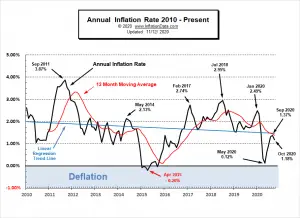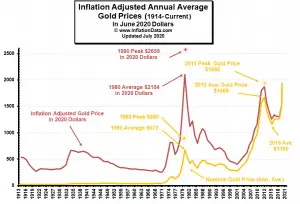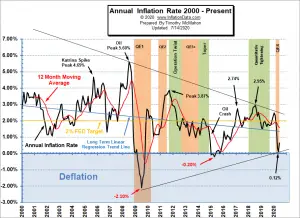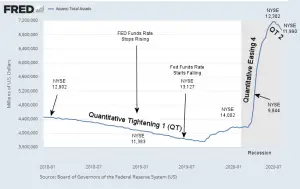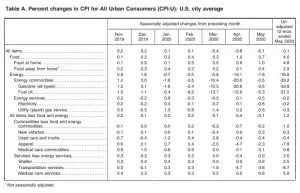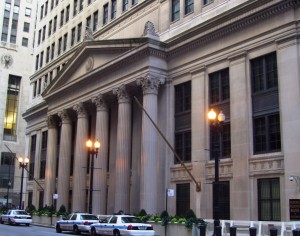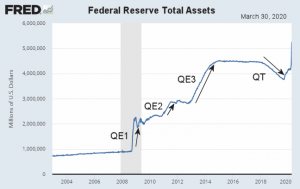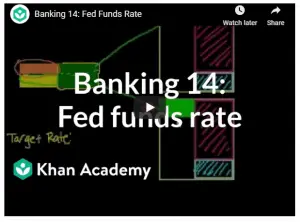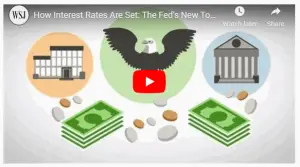Inflation Summary: Annual Inflation fell from 1.37% in September to 1.18% in October. CPI Index rose slightly from 260.280 in September to 260.388 in October. Monthly Inflation for September was 0.14% and only 0.04% in October. FED Funds Rates decrease slightly while FED Assets inch up. Next release December 10th Annual Inflation Chart: Looking at the Annual Inflation Chart since 1989 we can see a marked downward trend. Current Inflation Situation Looking at just the most recent 10 years the trend is … [Read more...]
3 Factors Causing the Current Gold Rally
A variety of factors affect the price of gold. Currently, many of them are combining to drive the price of gold to all-time record highs. Let's look at a few of the factors that affect the price of gold. 1) Uncertainty- Gold is a Crisis Hedge We have said this many times over the years but it bears repeating again gold is more of a crisis hedge than an inflation hedge. When uncertainty rears its ugly head... gold does well. That uncertainty can take many forms and one of them is "monetary uncertainty". So if people don't know what the value of their money is going to be in the future (i.e. inflation) they will shift some of their assets to gold (driving up the price of gold). So as far as … [Read more...]
Inflation Quintuples… Still Below 1%
Annual Inflation Rebounds Annual Inflation rose to 0.65%. CPI Index rose from 256.394 in May to 257.797 in June. Monthly Inflation for June was 0.55%, May was 0.002%, April was -0.67%, March was -0.22%, February was 0.27%. The FED may be slowing its "Quantitative Easing" in an effort to prevent hyperinflation. FED Funds Rate up slightly but still remains near Zero. Next release August 12th The Bureau of Labor Statistics Released the Inflation Data for the 12 months ending in June on July 14th. Monthly Inflation SOARS to 0.55%. Annual inflation for the 12 months ending in June was 0.65%, May was 0.12%, April was 0.33%, March was 1.54% down sharply from February's … [Read more...]
Is the FED Tightening or Is Hyperinflation on the Horizon?
Recently a prophecy has been trending on YouTube. In it, the possibility of major upheaval in November is mentioned, combined with the possibility of hyperinflation. As I've mentioned before, beginning in March 2020, the FED created massive amounts of liquidity through Quantitative Easing in an effort to combat the monetary effects of shutting the country down due to the virus. If that is combined with a reduction in the quantity of goods and services created due to the virus or riots shutting down the means of production we could see hyperinflation. So that would play into fulfilling that prophesy. Back on April 1st, I wrote an article entitled Will the $2 Trillion Covid-19 Stimulus … [Read more...]
May Inflation “Astonishingly Low”
The Bureau of Labor Statistics Released the Inflation Data for the 12 months ending in May on June 10th. Inflation is virtually ZERO at 0.12%. Annual Inflation Retreats Annual Inflation fell again to 0.12% in May from 0.33% in April. CPI Index rose marginally from 256.389 in April to 256.394 (virtually identical). Monthly Inflation for May was 0.002%, April was -0.67%, March was -0.22%, February was 0.27%... typically January through May are highly inflationary so this is VERY unusual. The FED continues to crank up the "printing presses" using "Quantitative Easing" in an effort to stimulate the economy in the wake of COVID-19. FED Funds Rate remains near Zero. Next … [Read more...]
What are Central Banks?
History of Central Banking Like everyone, kings like to spend money, whether it is to wage war or to build palaces, but they often didn't have all the money they "needed", so they had to borrow it. To facilitate this large scale borrowing, they created a Central Bank to handle that function. In 1790, "Federalist" Alexander Hamilton advocated for a Central Bank in the United States. Democratic-Republicans, Thomas Jefferson and James Madison believed that the Constitution did not grant the Federal government the authority to create a bank, based on the 10th amendment i.e. that all powers not endowed to Congress are retained by the States (or the people). But Hamilton argued that although … [Read more...]
Inflation Expectations and the Massive Fed Stimulus
Inflation is loosely described as a general economic state of rising prices. In February 2020, the US inflation rate dipped from a high of 2.5% in January, to 2.3%. Assuming the standard of steadily increasing prices, driven largely by food, fuel, and living expenses, one can expect the inflation rate to tick higher. Forecasts for April 2020 are at 1.7%. Given that the major drivers of inflation are excess demand (demand-pull inflation), or cost-push inflation, current conditions based on Coronavirus quarantines have created a murky demand climate. Oil Prices and Inflationary Expectations All major US indices, including the Dow Jones Index, have plunged precipitously. Stock portfolios … [Read more...]
What is the Federal Funds Rate?
By law banks are required to maintain a certain percentage of their assets in reserves at any given time. This money is held at the Federal Reserve bank and is called the “Reserve Requirement”. Generally, this money does not earn any interest. But, any money over and above this minimum can be loaned to other banks to who might not have enough reserves. The rate that banks can charge each other is called the “Federal Funds rate” or “Fed Funds Rate”. The monetary policy-making body of the Federal Reserve System, is called the “Federal Open Market Committee” or “FOMC”. The FOMC meets eight times a year to discuss the economy and decide on any changes to monetary policy. One of the major … [Read more...]
Will the $2 Trillion Covid-19 Stimulus Cause Inflation?
The current round of massive Corona Virus easing began Monday March 16th, 2020, with the FED buying $40 billion in Treasuries and then buying another $50 billion in Treasuries on Tuesday. By Thursday morning, it had upped the plan to $75 billion PER DAY and added $10 billion in mortgage securities. By Friday morning, the Fed had decided to buy $107 billion worth of Treasuries and mortgage-backed securities. In its first week, the FED purchased $317 billion worth of assets, which is slightly faster than the Fed balance sheet grew at the height of the 2008-2009 financial crisis. Initially, the Federal Reserve estimated purchases of $500 billion but FED chief Jerome Powell said the initial … [Read more...]
Does the FED Control Mortgage Rates?
For new home buyers, anything that increases the cost of the purchase (like rising mortgage interest rates) can negatively impact your ability to be able to afford your home. That is why everyone is concerned when the Federal Reserve (i.e. the FED) raises interest rates. The following chart shows how the Fed Funds Rate has performed from January 2015 through July 2019. The FED lowered the FED Funds rate to near zero in response to the market crash in 2008-2009. It kept it there until January 2016 when it began gradually raising rates. However, at their July end meeting, they decided to lower interest rates, reducing the federal funds rate target by 25 basis points, to a range of 2% to 2.25%. … [Read more...]

